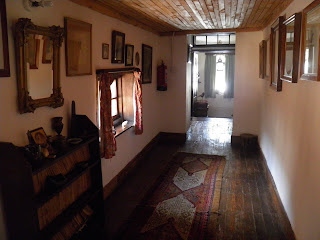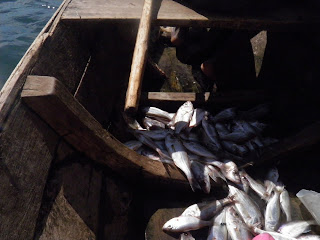What we found there, what we left behind and all the pot holes in between.
To begin I should tell you that the trip was initially planned for all of us, plus Mom's sister Ann. We had a little over two weeks and we were bound and determined to make it to the lake and a few other spots along the way. Unfortunately, Nora's immune system decided that having amoebic dysentary the week before her trip to Mayotte with Ann was just not enough, so she contracted Typhoid Fever a week later. She was all weak smiles when we decided that it would be best for her and Mom to stay home since she needed daily injections, something we were not sure we could pull off in the middle of the Zambian bush.
So off Dad Ann and I went into the land of Livingstone, Stewart Gore-Browne and countless other native Zambians before them.....
Our first stop was Kasanka National Park which is the first National Park in Zambia to be privately managed and funded entirely by tourism and private donations. The park is a 5-6 hour drive from Lusaka along the Great North Road. A note about the roads in Zambia. We found that having the person sitting shotgun had to be on constant pot hole watch in case a pot hole the size of a twin bed would suddenly appear out of nowhere.
Kasanka is very close to Bangwelu Wetlands and the park was full of birds, animals and marshy woodland surroundings. In November there is a very large bat migration and people flock to the park to see the bats take to the evening skys in search of dinner. We stayed in cute rondovals with warm bucket showers provided upon arrival and kerosene lanterns adorning the paths at night. We took an evening guided walk around the lake with Kennedy who was really there to protect the animals from us, instead us from the animals. In the morning we woke up early to climb the fibwe hide located 20 feet up an old Mahogany tree and a great place to see animals in the marsh provided that the grasses are not too high.

backpacks are so 2010....
Re-fuelling stop #2 unfortunately SUV's are the vehicle of choice for off roaders such as ourselves, but they sure do eat a lot of gas. Note the DAPP in the background. Nora and I came away from our Zambia experience with a bounty of second hand clothing that cost us no more than $2-3 per item. Keep donating all your clothes to Africa, they make a great business and even better buy!
This is what the road looked like the entire trip. Two weeks of endless grasses and one long asphalt strip. Not to mention the throngs of people always walking on the side of the road going where, coming from where we had no idea.
Our hot water showers were filled up per request.
Dad climbing up to the hide.
View from the hide. We did not see any Black Lechwe, a type of antelope, which tend to populate large marshes of Papyrus like this one. The grass was so tall all the animals were able to hide in it.
Sunset on the marsh
From Kasanka we took a small 50k detour to visit the site of the Livingstone Memorial. David Livingstone, famous for his "discovery" of Victoria Falls and his encounter with Henry Stanley ("Livingstone, I pressume?), died in Zambia durring his excursion to find the source of the Nile river. His heart was buried beneath a tree and then his body was carried by his two most faithful porters over 1,000 miles to the ocean where it was then sent to Britain.
We gave these ladies a ride up the road.
Livingstone Memorial
Beautiful Pointsettia tree.
We took another side trip this day, only 14k, which proved to be two hours out of our way and caused us to be terribly late in arriving at our next sleeping place. Normally this would not be a problem on a road trip. Except that in Zambia if you don't make it to the next town, well you saw the road, there are not very many alternative places to stay.
It was worth it though because we went to see Kundalila Falls or "Cooing Dove". Dad said he would like to be buried here. With good reason it looked out over a beautiful escarpment over the African bush.
We also found a beekeeping club on the way.
When we finally arrived that night at Kapishya Hot Springs it was well worth it to have pushed on through.
A brief history on Stewart Gore-Brown. English by birth. In 1911 he was in Africa working for the Anglo Belgian Boundary Commission to mark the border between Northern Rhodesia (Zambia) and the Belgian Congo. Durring this time he came across Lake Ishiba Ng'andu or "Lake of the Royal Crocodile. He managed to purchase the surrounding land and eventually constructed an English style Manor house in the middle of the African bush. His dream was to run a plantation of sorts and he experimented with many different crops eventually finding some success in the production of citrus fruit for essential oils. The farm however did not really ever take off as he would have liked. Later in life he became active in Zambia's struggle for independence and was a large educational supporter of one of Zambia's presidents Kenneth Kaunda. One grandchild still manages the estate as a farm and guest house while another has taken over the hot springs and hostel 20k away from the main house.
We stayed at the hot springs, which were really only tepid springs compared to some in the states, took a few walks around the area to some rock paintings and waterfalls and we went on a tour of the house just to see what all the hype was about.
The hostel had a pool since the river was full of crocodiles.
The extensive gardens at the hostel.
Rock paintings
Bark cloth and bark rope are one of the more fascinating things I discovered in all of my travels around Zambia.
Someone was washing dishes.
Near the hot springs they are using a natural waterfall to install a small hydro electric plant to provide electricity to the surrounding community. Problem is no one in the community can afford to hook up or even run the power.
Shiwa Ng'andu
Inside the house.
Flora of the area.
From Shiwa we hit the road again. This time our destination was Mpulungu on the shores of Lake Tanganyika. The lake is the worlds longest freshwater lake and second deepest. It is the largest rift lake and is home to many kinds of Cichlid fish, the pretty bright and colorful tropical ones. We stayed at a lovely hostel with stone rondovals and friendly staff. We spent a day rowing on the lake, walking around town and the harbor and we also spent a day in search of Kalambo Falls which according to the Lonely Planet was an hours drive on a nice paved road. What we found to be true was a three hour drive on the worst road of the drip full of deep crevices, mud, stones and switchbacks that eventually gave us a flat tire. But we made it! And it was worth it. The falls were beautiful and we made good friends along the way.
Some folks hitching a ride.
On the lake. Dad kept us afloat by bailing the whole ride.
We stopped some fisherman and our boatman bought some fresh fish.
Kalombo Falls
Tanzania to the right, Zambia to the left.
Dad and Fred fixing the tire.
From the lake we headed back South to meet Nora, who had recovered, and mom at our last stop on the trip, The Mutinondo Wilderness area. This by far was our most favorite place of the trip and quite lucky that we all got to be there together. We spent our days hiking, watching the sunsets, sharing our breakfast with the horses and feasting on some culinary delicacies in the evenings at the lodge by candlelight.
My camera died at this point but the lodge website has lovely pictures of the
area.
Ann's tent overlooking the escarpment.
Our outdoor kitchen where the horses liked to visit.
evening time
This is definitely a place to travel to, return to and experience.
Our trip was a lot of driving. I think we all came to understand the grandness of the African continent better. It was a great close to my time in Zambia. I can now say I have been to all corners of the country and have driven on the four paved roads that exist there.
-Lebo
 Once back in Lusaka the new academic term began in earnest. I lecture in 4 courses, one of graduate students in reference needs, service and sources and two undergraduate courses - school libraries and the introductory course.
Once back in Lusaka the new academic term began in earnest. I lecture in 4 courses, one of graduate students in reference needs, service and sources and two undergraduate courses - school libraries and the introductory course.



























































